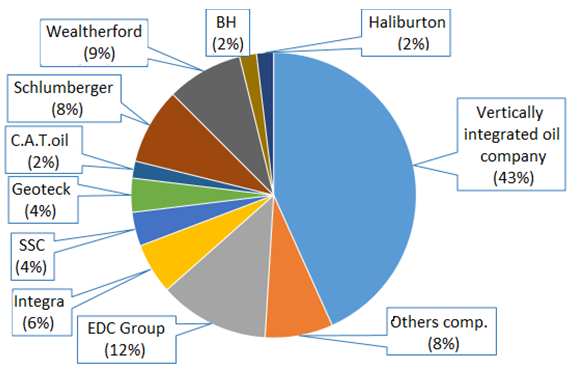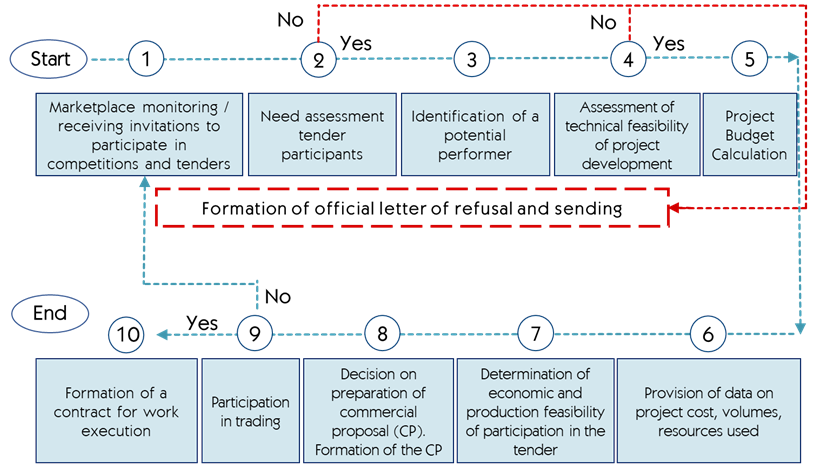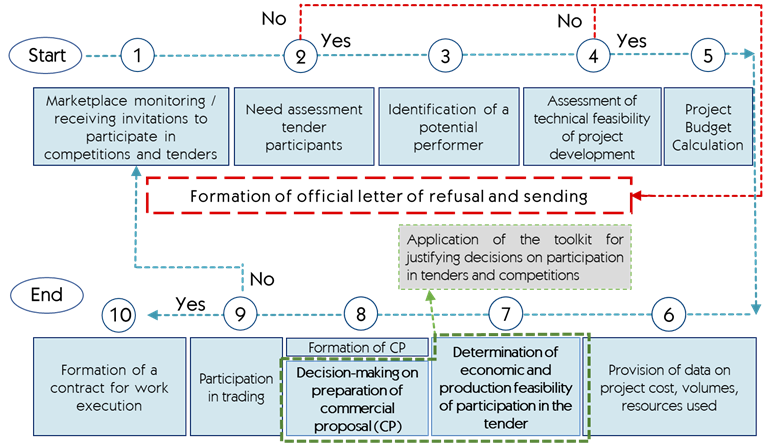IMPLEMENTATION OF THE ECONOMIC AND MATHEMATICAL MODEL IN THE PROCESS OF COMMERCIAL OFFER PREPARATION AND REALIZATION OF OILFIELD SERVICES IN THE RUSSIAN MARKET
ВНЕДРЕНИЕ ЭКОНОМИКО-МАТЕМАТИЧЕСКОЙ МОДЕЛИ В ПРОЦЕСС ПОДГОТОВКИ И РЕАЛИЗАЦИИ КОММЕРЧЕСКОГО ПРЕДЛОЖЕНИЯ НЕФТЕСЕРВИСНЫХ УСЛУГ НА РОССИЙСКОМ РЫНКЕ
Научная статья
Колесникова О.И.1, *, Ульянов А.П.2
1 ORCID: 0000-0001-7624-6021;
1, 2 Уфимский государственный нефтяной технический университет, Уфа, Россия
* Корреспондирующий автор (olama80[at]yandex.ru)
АннотацияВ условиях сложной экономической ситуации и снижения цен на углеводороды, спрос на нефтесервисные услуги падает. Снижение рынка приводит к обострению конкурентной борьбы российского и зарубежного сегмента нефтесервисных компаний. В наибольшей степени, конкуренция присутствует на этапе конкурсов и тендеров. Значимой составляющей «конкурентной борьбы» является решение менеджмента компании о том, в каких конкурсах следует участвовать, а в каких нет. От выигранного тендера зависит не только влияние компании на рынок присутствия, но и обозначение компании среди конкурентов на рынке. Использование предлагаемой экономико-математической модели позволит формировать такие условия участия в тендерах по оказанию нефтесервисных услуг, которые будут наиболее предпочтительными и экономически эффективными для нефтесервисных компаний. А выигранные, по результатам анализа математической моделью, тендеры позволят компании укрепить свои позиции на рынке нефтесервиса.
Ключевые слова: нефтесервисные услуги, конкуренция, экономико-математическая модель, тендер, коммерческое предложение, экономическая эффективность, рынок, ВИНК, система.
IMPLEMENTATION OF THE ECONOMIC AND MATHEMATICAL MODEL IN THE PROCESS OF COMMERCIAL OFFER PREPARATION AND REALIZATION OF OILFIELD SERVICES IN THE RUSSIAN MARKET
Research article
Kolesnikova O.I.1, *, Ulyanov A.P.2
1 ORCID: 0000-0001-7624-6021;
1, 2 Ufa state petroleum technological university, Ufa, Russia
* Corresponding author (olama80[at]yandex.ru)
AbstractUnder the conditions of a difficult economic situation and declining prices of hydrocarbons, the demand for oilfield services is falling. Decrease in the market leads to aggravation of competition between Russian and foreign segment of oilfield services companies. The competition is mostly present at the stage of tenders and contests. An important part of the "competitive struggle" is the decision of the company's management about the participation in tenders. The won tender affects not only the company's influence on the presence market, but also the designation of the company among the competitors in the market. The use of the proposed economic and mathematical model will make it possible to form such tender participation conditions for oilfield services which will be the most preferable and cost-effective for oilfield service companies. Won tenders based on the results of the mathematical model analysis will allow the company to strengthen its position in the oilfield services market.
Keywords: oil services, competition, economic and mathematical model, tender, commercial offer, economic efficiency, market, VIOC, system.
At present, the development of the oilfield services segment for Russian oil and gas companies operating under the conditions of sanctions applied by foreign countries, as well as the lack of stable oil prices, is an urgent problem. Service companies are one of the leading elements of innovative development of the fuel and energy complex in Russia, providing both stabilization of oil production in oil and gas bearing regions and acceleration of involvement in development of fields with TRIZ, which are considered unprofitable.
In the business development of oil and gas companies it is important to manage costs, to determine the ways of reducing prime costs in order to increase profits and production efficiency.
To reduce costs in the oilfield service market, oil and gas companies use two approaches: outsourcing and vertical integration. During vertical integration work is carried out by the company's own divisions, or involving oil and gas service enterprises integrated into the structure of the oil and gas company. This approach allows to control the process throughout the entire production cycle and to save on control by third parties and suppliers. Profit is increased through market domination. However, maintenance of subdivisions or enterprises integrated into the company structure requires high costs which can reduce economic effect to zero [1].
The use of outsourcing assumes granting of non-core assets to the third-party service enterprise for performance of set tasks. The enterprise refuses unprofitable projects and business activities and focuses the released resources on the main line of business. It also allows reducing expenses for the maintenance of additional personnel. The main advantage of outsourcing is that the contractor has highly qualified specialists, huge experience in the performance of set tasks, as well as constantly improving technology. Shortcomings of outsourcing include the risk of improper quality of the completed order, lack of organizational involvement and loss of control over strategically important technological processes. Also, the disadvantages of outsourcing include the lack of development of this direction in Russia [2].
More than 200 oil service companies are registered in Russia. The companies are divided into enterprises within VIOC (affiliated), large oilfield service companies, medium and small oilfield service companies. The market share of oilfield services within VIOC accounts for 43%. These include PJSC Rosneft, PJSC Surgutneftegas and others. Eurasia Drilling Company LLC accounts for the largest share of services among independent companies in Russia (13% of the total). Among foreign companies, Haliburton, Weatherfor and Schlumberger (18% of the market) have the largest shares (see figure 1) [1].
Fig. 1 – Oil service market in Russia (by size of revenue)
The oil service market is segmented in terms of the type of provided services and their cost. Foreign "giants" focus on providing complex and specific oilfield services that require high qualification and the latest technologies. Companies within the framework of VIOC provide a wide range of services, high quality, but at the cost many times higher than that of small oilfield service companies providing a limited number of low or medium quality level services. Until 2014 VIOC used the services of these foreign "giants", but after the introduction of sanctions access to the services of these companies in Russia was limited. Thus, VIOC covers its own demand, in most cases by domestic oil service companies. And contracts concluded with external oilfield service companies have a short term, which does not give the companies a stable monetary income in the long term. This affects the level of services provided, the quality of which plays a key role in choosing a contractor to fulfill an order [3, P. 21].
In order to develop outsourcing services and to enter the market, small oilfield service companies need to improve the skills of their employees as well as update their equipment. This will result in the possibility of introducing innovative technologies in the production activities of oilfield and in involving service companies in large long-term projects depends on this.
The state actively participates in the development of the oil service market. The Government of the Russian Federation has taken measures of state support – subsidizing the interest rate in introduction of technologies and imported equipment privileges in terms of VAT, etc. [4]. The Industrial Development Fund established in 2014, co-financing, as well as support by large oil companies for further commercialization are designed to stimulate the development of oilfield services in Russia. This will be followed by the subsequent refusing foreign companies, such as Norway (the share of Norwegian service in field development is > 90%).
Thus, the sanctions imposed, which resulted in the restriction of foreign companies' access to the domestic market, as well as growing indicators of drilling volumes, provide opportunities for the growth of the Russian oil service market, creation and implementation of new technologies developed by domestic specialists and development of oil service enterprises in Russia (see table 1).
Table 1 – Challenges and opportunities of the oilfield services market in Russia
| Challenges | Opportunities |
| Sanctions | |
| Offshore development | Hydraulic Fracturing Development |
| Restriction of access to foreign developments and services. | Market launch of a new product/service |
| Deteriorating of mining conditions | |
| Requirements for technical equipment | Growing demand for drilling services |
| Consolidation around VIOC | |
| Loss of contracts with independent companies | Technology development around VIOC |
| Market peculiarities of Russia | |
| Poor infrastructure | Competitiveness of Russian oil (price) |
| Poor management effectiveness | Entering new markets |
| Government regulation of oilfield services | |
We can draw a conclusion about the development of the oilfield services market in Russia, including the development of independent oilfield services companies and outsourcing, which leads to increasing competition among companies - "established" market participants and young companies.
Most of all, rivalry is present at the stage of competitions and tenders. An important part of competition is the decision of the company's management about the participation in tenders. The won tender will affect not only the company's influence on the presence market, but also the designation of the company among the competitors in the market. Thus, it is necessary to take into account restrictions in the company resources as well as probability of gain and possibility of price decrease (fall) from the maximum price of the contract for preservation of the necessary profitability.
The figure shows a standard model of the process of preparation and implementation of an oilfield service company's commercial offer in the Russian Federation (see figure 2).
Fig. 2 – Process of preparation and implementation of commercial offer of oilfield service companies in Russia
In this model we can see that trading platforms are monitored, and then experts make decisions about which competition to participate in and on what conditions. The main decision-making tool in this model is the expert who is responsible for the tender policy in the company. In the current conditions of a constantly changing market, using the existing expert decision-making about participation in tenders is not enough [5, P. 1121].
The increase of the efficiency of tender bidding can be done by creating a mathematical model that takes into account the probability of winning, determined by both experts and the possibility of introducing artificial intelligence based on previous experience of participation in tenders [6]. This model can be easily built into the process of preparation and implementation of a commercial offer, slightly modifying it (see figure 3).
Fig. 3 – Improvement of the process of preparation and implementation of commercial offer of oil service companies in Russia
The maximization of the ratio of income received on the basis of the results of performed work to the amount of expenses for performance of works (services) is accepted as a target function.
| ∑Пк → max, | (1) |
Pci – competitive profit amount on the results of the i-th won tender, rub;
Picomp – tender price of the contract for execution of the i-th type of tender, rub/pc;
Qinecess – required production capacity (resources) to execute the i-th tender, pcs;
Сi – cost of execution of the i-th type of tender, rub.
- Under the condition of sufficient production capacity to perform the won tenders:
| Qavail≥Qnecessi, | (4) |
- The possibility of winning the i-th type of tender:
| 0% ≤ Wi ≤ 100%, | (5) |
Wi – probability of winning the i-th tender, %
It is proposed to accept additional parameters required for the work of the developed mathematical model:
- Under the condition of contract price change which does not exceed L of the initial contract value:
| Picomp≥ Piniti – (Pinit i*Lxi) | (6) |
- Under the condition of deviation of the contract price from the original one, based on the possibility of winning the tender:
| Lxi ≤ Lx I ; | (7) |
| а) Wi ≥ Z, | (8) |
| |
(9) |
| b) Wi ≤ Z ; | (10) |
| (11) |
- Under the condition of the deadline for submission of documents for participation in the contest:
| D1 < Di , | (12) |
- Under the condition of exceeding the minimum price threshold for the execution of the tender, the cost of work on its execution:
| |
(13) |
К – the interest rate necessary to overcome the payback threshold of the i-th tender contract executed, %.
The model is implemented on the basis of MS Office Excel by means of "solution search" analysis.
The use of the proposed economic and mathematical model will make it possible to form such conditions for tenders participation that will be the most preferable and cost-effective for oilfield service companies. And the won tenders based on the results of the analysis of the mathematical model, will allow the company to strengthen its position in the oil service market [7], [8], [9].
Thus, we can draw a conclusion about the development of the oilfield services market in Russia, in particular, the prerequisites and opportunities for the development of oilfield services companies. To strengthen their positions, oilfield service companies need to increase their competitiveness (to upgrade technical equipment, to conduct continuous training of personnel) [10]. In the same way companies should improve their production facilities, not only in terms of production equipment, but also technically (subprocesses of production), introduce new technologies that increase production efficiency. The state should actively support these companies by introducing measures to protect domestic companies, tax benefits, and encourage import substitution in the development and production of equipment by subsidizing the interest rate for manufacturers, etc.
| Конфликт интересов Не указан. | Conflict of Interest None declared. |
Список литературы / References
- Исследование российского нефтесервисного рынка в 2016-2017 гг. [Электронный ресурс] / URL: https://assets.kpmg/content/dam/kpmg/ru/pdf/2017/11/ru-ru-oilfield-service-companies.pdf (дата обращения: 18.05.2020).
- Обзор нефтесервисного рынка России – 2019 [Электронный ресурс] / Исследовательский центр компании «Делойт» в СНГ Москва. URL: https://wwwdeloitte.com/content/dam/Deloitte/ru/Documents/energy-resources/Russian/oil-gas-russia-survey-2019.pdf (дата обращения: 09.06.2020).
- Шоч Б. Пятилетка надежд / Б. Шоч // Oil&Gas Eurasia. – 2015. – №3. – С. 20-25.
- Антропова А.С. Формирование эффективного рынка нефтегазового сервиса: мировой и отечественный опыт: монография / А. С. Антропова, А. В. Павловская. – Ухта : УГТУ, 2016. – 102 с.
- Gaisina L.M. Russian energetic industry enterprises: social orientation of the information management / L.M. Gaisina, O.I. Kolesnikova, A.V. Medvedeva, A.R. Fayruzova, E.V. Lopatina, E.L. Effimenko // Journal of environmental management and tourism. – 2017. – V. 8. – № 5 (21). – P. 1119-1131.
- Kolesnikova O.I. Economic order quantity for oil products as exemplified by Lukoil-Uralnefteproduct company. / O.I. Kolesnikova, Y.G. Pershin // Nauka Krasnoyarya. – 2017. – V. 6. – № 1-2. – P. 181-186.
- Kolesnikova O.I. The improvement of the efficiency of fixed assets as a factor of economic security of the public joint-stock company “Vostokneftezavodmontazh” / O.I. Kolesnikova O.I., D.R. Tamindarova // Krasnoyarsk science. – 2020. – № 4-2. – P. 7-18.
- Лазаренко А. А. Методы оценки конкурентоспособности / А.А. Лазаренко // Молодой ученый. – 2014. – С. 374-377.
- Котов Д.В. Организация производства в нефтяной и газовой промышленности: учебное пособие / Д.В. Котов, И.М. Захарова – Уфа: Издательство УГНТУ, 2014 – 63 с.
- Воронов Д. С. Динамический подход к оценке конкурентоспособности предприятий / Д.С. Воронов // Маркетинг в России и за рубежом. – 2015. – С. 15-21
Список литературы / References in English
- Issledovanie rossijskogo nefteservisnogo rynka v 2016-2017 gg. [Study of the Russian oil service market in 2016-2017.] [Electronic resource] / URL: https://assets.kpmg/content/dam/kpmg/ru/pdf/2017/11/ru-ru-oilfield-service-companies.pdf (accessed: 18.05.2020). [in Russian]
- Obzor nefteservisnogo rynka Rossii – 2019 [Review of the Russian oilfield services market – 2019] [Electronic resource] / Deloitte Research Center in CIS Moscow.URL: https://www2.deloitte.com/content/dam/Deloitte/ru/Documents/energy-resources/Russian/oil-gas-russia-survey-2019.pdf (accessed: 09.06.2020). [in Russian]
- Shoch B. Pjatiletka nadezhd [Five years of hope] / B. Shoch // Oil&Gas Eurasia. – 2015. – N3. – P. 20-25[in Russian]
- Antropova A. S. Formirovanie jeffektivnogo rynka neftegazovogo servisa: mirovoj i otechestvennyj opyt [Formation of effective oil and gas service market: international and domestic experience]: monograph / A. S. Antropova, A. V. Pavlovskaja. – Ukhta : Ukhta State Technical University, 2016. – 102 P. [in Russian]
- Gaisina L.M. Russian energetic industry enterprises: social orientation of the information management / L.M. Gaisina, O.I. Kolesnikova, A.V. Medvedeva, A.R. Fayruzova, E.V. Lopatina, E.L. Effimenko // Journal of environmental management and tourism. – 2017. – V. 8. – № 5 (21). – P. 1119-1131.
- Kolesnikova O.I. Economic order quantity for oil products as exemplified by Lukoil-Uralnefteproduct company. / O.I. Kolesnikova, Y.G. Pershin // Nauka Krasnoyarya. – 2017. – V. 6. – № 1-2. – P. 181-186.
- Kolesnikova O.I. The improvement of the efficiency of fixed assets as a factor of economic security of the public joint-stock company “Vostokneftezavodmontazh” / O.I. Kolesnikova O.I., D.R. Tamindarova // Krasnoyarsk science. – 2020. – № 4-2. – P. 7-18.
- Lazarenko A. A. Metody ocenki konkurentosposobnosti [Methods of competiveness assesment] / A.A. Lazarenko // Molodoj uchenyj [Young scientist]. – 2014. – P. 374-377. [in Russian]
- Kotov D.V. Organizacija proizvodstva v neftjanoj i gazovoj promyshlennosti: uchebnoe posobie [Production management in oil and gas industry: study guide] / D.V. Kotov, I.M. Zaharova – Ufa: Publishing house of UGNTU, 2014 – 63 p. [in Russian]
- Voronov D. S. Dinamicheskij podhod k ocenke konkurentosposobnosti predprijatij [Dynamic approach to competiveness assesment of the enterprise] / D.S. Voronov // Marketing v Rossii i za rubezhom [Marketing in Russia and abroad]. – 2015. – 15-21. [in Russian]



